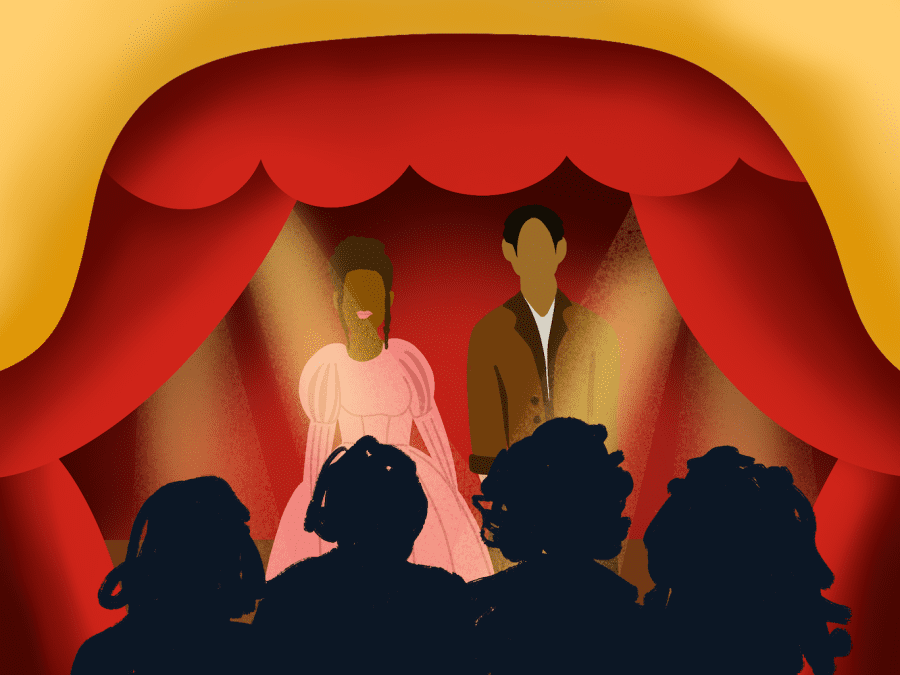Flipping the script: Diversifying American show business
Racism in the theater industry propelled these NYU professors and students to find their footing in the field.
(Illustration by Susan Behrends Valenzuela)
October 24, 2022
Institutional racism sits at every level of American theater, with limited opportunities for people of color to flourish in the industry and make their mark. Moreover, as a massive university with several classes offered in the theater and film departments, NYU runs the risk of only teaching mainstream plays to students, further dividing the industry. But this hasn’t stopped many NYU community members from fighting against racism in the industry and finding success in their careers.
Kristoffer Diaz, a clinical associate professor at NYU’s Gallatin School of Individualized Study and an associate arts professor in the Rita and Burton Goldberg Department of Dramatic Writing at Tisch, has dedicated his career to increasing opportunities for people of color in the theater industry.
“Anytime that students — especially in a school like NYU, that is so international and so diverse — anytime that we’re not giving students opportunities to see different kinds of works that they’re going to respond to, we’re in danger of not serving them as well as we could,” Diaz said.
In 2000, Diaz began working in the industry. He soon realized that many of the productions theaters were putting on at the time, focused on narratives that mainly staged a white story with a white cast. Seeing monochromatic theater propelled him to create works that felt personal to his identity as a person of color from Puerto Rico.
Diaz’s play, “The Elaborate Entrance of Chad Deity,” tells the story of a professional wrestler who realizes that success in the field is more complicated than he thought. Diaz wrote this play at a time when he felt like he didn’t belong in the theater industry. Chad Deity’s story of navigating a foreign industry felt similar to his own. The play was a finalist for a Pulitzer Prize, which set the stage for many other people of color to create works that felt authentic to them. Currently, Chance Theater in California is presenting a month-long run of “The Elaborate Entrance of Chad Deity.”
“I’m not going to listen to anybody who says, ‘Why would you write a play about professional wrestling, about people of color?’” Diaz said. “I’m just going to lean into it because that’s what I want to do.”
Diaz said that as a faculty member of NYU, it’s his responsibility to present students of color with the opportunity to engage with artists who belong to different ethnicities. He believes the first step toward including people of color in show business starts with educating and inspiring the future generation of theater makers not to always follow in the steps of their predecessors. More than half of his classes’ syllabi have works from people of color.
Tisch senior Brandon Bautista discovered his love for theater after taking a general education arts course during his first semester of college. After watching “Who Shot La Miguelito?” by Sean San José, which explored the death of a street artist and the rising gentrification in immigrant neighborhoods in San Francisco’s Mission District, Bautista decided to dedicate his life to theater and the art of storytelling.
During the pandemic, he created and acted in a short film titled “Settle,” a love letter to Filipino parents struggling with dislocation. Bautista was inspired to make the film when he heard stories from his family about immigrating to the United States.
“I took this as an opportunity to revitalize that tradition, to pass down and feature my Filipino heritage and reformulate it into what drives me: acting and writing,” Bautista said. “I am the first in my family to pursue an artistic career, so collaborating with my parents was an opportunity to share and connect the intersections of my identity as a Filipino American and theater artist.”
Currently, Bautista is working on “exhibition: Fil-O-PiNOS,” a show for NYU Tisch. The series features a Filipino American family who inherits a run-down restaurant in the Bay Area, California. The characters in the show have to identify and grapple with their identity as Filipinos in a non-native country, and what that means when the establishment of one legacy clashes with the healing of another.
In his playwriting classes, Diaz urges students to create works that feel authentic to them. His students have written plays about growing up in different parts of the world, including India and the Philippines, and personal experiences that deal with family and intergenerational trauma.
“Somebody who’s a student of anything, but certainly a student of life, a student of a particular art form, should be hungry to know what’s out there,” Diaz said. “In the theater world, if you just know the American play style with people sitting on a couch drinking wine that are just about wealthy, usually white folks, if you only know that, then you’re missing out on a ton of really exciting work.”
Michael Dinwiddie, an associate professor at Gallatin, said that when he started working in the theater industry, the medium felt alien to him because of the lack of African American representation.
“When I first came to New York, I worked as an actor, and I got very discouraged because all the roles for Black men were pimps and drug dealers and things like that,” Dinwiddie said. “And I just thought, ‘You know, I don’t want to do that.’”
Dinwiddie is currently working to construct an African Grove Theatre at NYU at 181 Mercer Street. Since their establishment, African Grove productions have served as a forum for positive and revolutionary depictions of Black and Indigenous life in the United States. Diaz said that if theater students only read unoriginal and overused plays, then their perspective can be limited.
“It’s important to know what’s come before you, to know it in all its complicated ways,” Diaz said. “History is messy and flawed and sometimes really inspirational and wonderful and sometimes really terrible at the same time. For students to be able to understand that and engage with it in whichever ways they can best do so to make sense of the world and make art out of it, that’s the kind of stuff that we can do.”
In the theater’s productions, Black actors were cast in prominent roles initially considered for a white cast. Inspired by the African Grove productions, Dinwiddie wants African American theater practices to stay alive and grow in a world with a history of shutting down theaters engaging with Black works and artists. He believes that educating people is about changing how society has functioned in the past, which will happen when students are exposed to a diverse body of work.
“We have to change the ways in which theater is being done in this country so that everyone has the opportunity to be on stage, to work backstage, to work as actors,” Dinwiddie said. “We shouldn’t see monochromatic theater. We shouldn’t see one racial group producing or anything. Anybody should be able to work and do theater in America.”
Ricky Kapoor, a junior at Tisch studying film and television production, feels like he has a story to tell because of his experience growing up in India, which contrasts his current experience of studying in the United States.
“Every person of color has been screwed over by Hollywood, but brown people had a really tough journey because we were basically just funny jokes for like forty years,” Kapoor said.
Kapoor is working on a script that will be made into a film next semester. The story is loosely based on his grandparents, an Indian couple living in New Jersey. The film centers around an unconventional husband looking to rekindle his relationship with his distant, conservative wife.
The representation of people of color in the theater industry is improving. A study conducted by the University of California, Los Angeles found that leading roles played by people of color in last year’s 200 films have increased since 2011 when less than 11% of the cast in more than half of the films belonged to minority groups. But Kapoor said that there’s still a long way to go, especially because brown people are often given mediocre, stereotypical roles to play.
Diaz relates to the ups and downs students face stepping into the theater industry as he was once in their place. He realizes many people are wary of getting into the artistic field as it doesn’t guarantee instant success.
“It’s a terrifying thing,” Diaz said. “A lot of my students come out of here with a lot of debt, and in the best-case scenario, they’re going into fields in which they’re not necessarily going to make a ton of money right away. It’s not like they’re going into debt to become a lawyer or a doctor. They’re following their dreams, and there’s definitely potential for making a good amount of money, establishing a good career, but it’s scary.”
At a racially diverse institution like NYU, microaggressions in classes can leave people of color feeling wary of the entertainment industry. Diaz said that when someone’s peers might say something culturally insensitive and problematic, students need the space to find out whether and why something is hurtful.
“We need to find ways to engage with those incidents and seek punishment when it’s appropriate,” Diaz said. “We need to know how to fight through that stuff and we need to know how to make the work that we want to make regardless of whether people get it. No piece of art is going to be understood by everyone.”
Theater students stand where these professors once stood: at the crossroads of choosing to push forward in this industry or leave it all behind. Bautista says the decision for him to remain in the field is even more crucial, and the stakes are higher because he belongs to a marginalized group.
“I don’t have the luxury to give up,” Bautista said. “So many of us, especially those in marginalized communities, have people who’ve sacrificed so much to get to where we are now. It’s either this or nothing. I chose to do art, and I must pursue it. I can’t allow myself to end everything in disappointment. This doesn’t mean I can’t feel defeated or like I’ve failed. But failure is powerful, invigorating and important.”
Contact Nandini Gupta at [email protected].


























































































































































